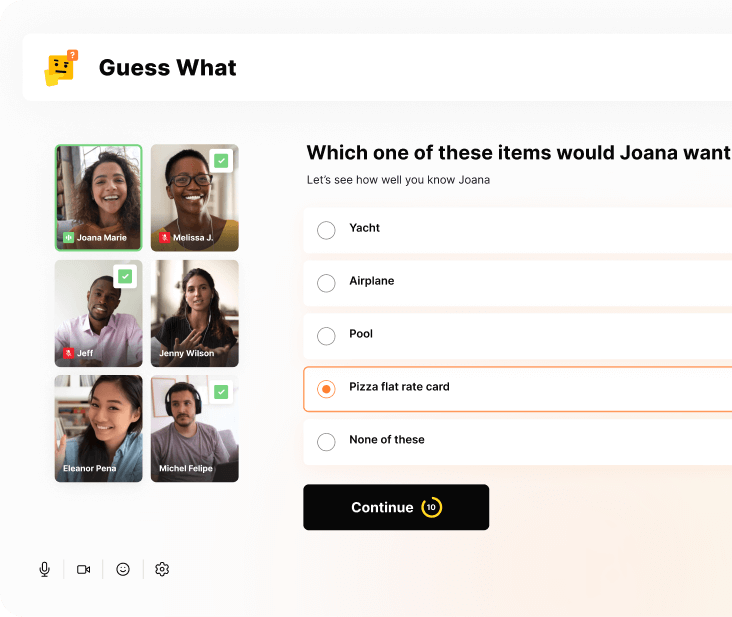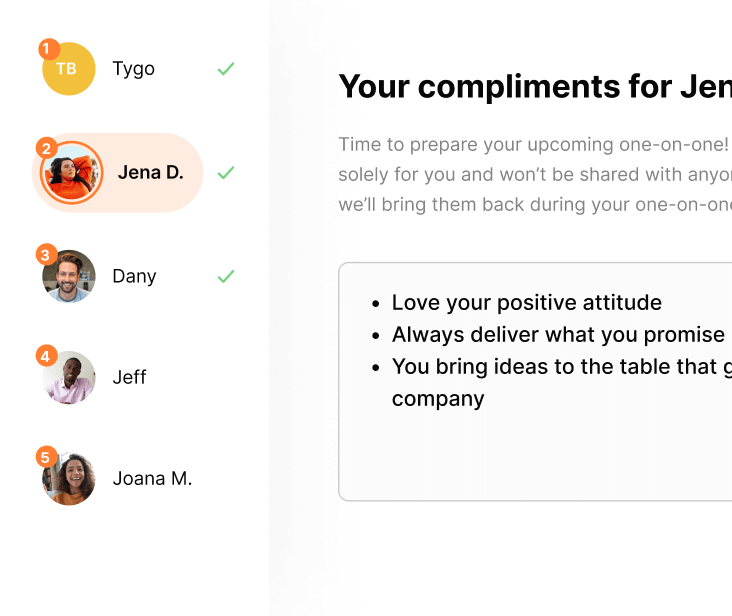Back to Blog
Employee engagement pulse surveys: What are they really?
As a manager, it is crucial to regularly monitor employee engagement levels and drivers.
But what is a pulse survey, and how does it differentiate from a normal employee engagement survey?
Keep reading for examples of pulse survey questions you can add to your next employee engagement pulse survey.
The difference between a ‘normal’ employee engagement survey and a pulse survey
The differences between engagement surveys and pulse surveys are quite big. Before deciding on using a pulse survey in your organization, it is important to understand how these two surveys differ.
1. Employee engagement survey
An employee engagement survey measures employee satisfaction and gathers opinions from the employees on where your company is succeeding and where it needs improvement too.
Compared to the pulse survey, an employee engagement survey looks at the company from a holistic perspective. Engagement surveys are longer than pulse surveys and take about 10-30 minutes to fill out. Hence, sending out the employee engagement survey quarterly or twice a year is recommended. Here are some of the things an employee engagement survey typically covers:
- Work-life balance
- Benefits
- Inclusivity, diversity, and fairness
- Overall satisfaction
- Company culture
- Relationships with the manager
- Goal setting
- Career growth opportunities
2. Pulse surveys
Pulse surveys focus on measuring more specific areas of the company and teams. They are usually more frequent (e.g., weekly) and take less time than an engagement survey.
Pulse surveys are an essential indicator of employee engagement and satisfaction in real time and help you understand the current feelings, motivators, and de-motivators of the team.
A pulse survey usually covers:
- Sentiments about current affairs and changes in the company
- Recognition and feedback
- Employee wellbeing
- Safety
- Relationship with colleagues
- Relationship with manager
- Onboarding (for new employees)
Pulse surveys usually measure specific metrics which are constantly updated with each employee’s answer. The results of these metrics show that the team leads can take specific actions, and the goal should always be to better the metrics.
Share fun facts and bond with a team quiz
Have your participants choose from a list of questions they’d like their coworkers to answer about them, before watching as they guess the right answer.
01. Yes
share-fun-facts-and-bond-with-a-team-quiz

Run a guided recognition activity
Have your participants choose from a list of questions they’d like their coworkers to answer about them, before watching as they guess the right answer.
01. Yes
run-a-guided-recognition-activity

Organize a virtual cooking class
Hire a professional chef to help your team cook a delicious lunch or dinner. May be difficult for co-workers with families. To find providers and get tips, read our blog about virtual cooking classes.
02. No
organize-a-virtual-cooking-class

Hire a stand-up comedian
Have your participants choose from a list of questions they’d like their coworkers to answer about them, before watching as they guess the right answer.
02. No
hire-a-stand-up-comedian

No items found
No items found
Table of contents
As a manager, it is crucial to regularly monitor employee engagement levels and drivers.
But what is a pulse survey, and how does it differentiate from a normal employee engagement survey?
Keep reading for examples of pulse survey questions you can add to your next employee engagement pulse survey.
The difference between a ‘normal’ employee engagement survey and a pulse survey
The differences between engagement surveys and pulse surveys are quite big. Before deciding on using a pulse survey in your organization, it is important to understand how these two surveys differ.
1. Employee engagement survey
An employee engagement survey measures employee satisfaction and gathers opinions from the employees on where your company is succeeding and where it needs improvement too.
Compared to the pulse survey, an employee engagement survey looks at the company from a holistic perspective. Engagement surveys are longer than pulse surveys and take about 10-30 minutes to fill out. Hence, sending out the employee engagement survey quarterly or twice a year is recommended. Here are some of the things an employee engagement survey typically covers:
- Work-life balance
- Benefits
- Inclusivity, diversity, and fairness
- Overall satisfaction
- Company culture
- Relationships with the manager
- Goal setting
- Career growth opportunities
2. Pulse surveys
Pulse surveys focus on measuring more specific areas of the company and teams. They are usually more frequent (e.g., weekly) and take less time than an engagement survey.
Pulse surveys are an essential indicator of employee engagement and satisfaction in real time and help you understand the current feelings, motivators, and de-motivators of the team.
A pulse survey usually covers:
- Sentiments about current affairs and changes in the company
- Recognition and feedback
- Employee wellbeing
- Safety
- Relationship with colleagues
- Relationship with manager
- Onboarding (for new employees)
Pulse surveys usually measure specific metrics which are constantly updated with each employee’s answer. The results of these metrics show that the team leads can take specific actions, and the goal should always be to better the metrics.
Examples of pulse survey questions
Pulse surveys should tackle smaller and immediate issues/concerns/topics in your organization.
While the surveys can be answered in a ‘yes’ and ‘no’ manner, we recommend having a scale of 1 to 5 to gain a deeper understanding of the answer. Here are just some of the examples of questions you can add to your pulse survey:
1. Sentiments about current affairs and changes in the company
- Our organization has done a good job in informing people about X
- My manager has done a good job in supporting me through X
- I have received all the relevant information about X
- I believe that the communication about X was explained in a transparent manner
- We have effectively managed the recent change in our organization
2. Recognition and feedback
- I believe that recognition in my organization is being given on time
- The feedback I receive assists me in growing as a professional
- My manager gives feedback in an easy-to-understand manner
- I feel recognized and valued in my workplace
- I feel comfortable giving feedback to my manager
3. Employee wellbeing
- My organization cares about my health and wellbeing
- I receive support when I ask for it
- I have a good work-life balance
- My organization provides me with mental health support when I ask for it
- I feel comfortable sharing with my manager when I feel stressed
- How do you feel about the level of work-related stress this week?
4. Safety
- I feel safe in my work environment
- My safety is a priority for my manager
5. Relationship with colleagues
- I feel a sense of belonging amongst my colleagues
- My colleagues care about me
- I feel a sense of connectedness with my colleagues
- I can count on my colleagues to help me when needed
6. Relationship with manager
- My manager cares about me and my wellbeing
- I trust my manager
- I have open communication with my manager
- My manager provides me with the guidance I need to complete my daily tasks
7. Onboarding of a new employee
- I feel I have received adequate support during my onboarding
- I feel accepted by my new colleagues
- My job responsibilities are as I expected them to be
Pulse survey tools and templates to get you started
An employee engagement pulse survey is a crucial component in understanding your team’s needs and how you can improve what is impacting your colleagues and employees from doing their best work.
The sooner you start measuring employee engagement and satisfaction, the better. Here are some of our favorite tools:
If you are looking for some more employee engagement apps, you might want to check out this blog post. We also have written extensively about virtual employee engagement platforms and other solutions.
However, if you are not ready to choose a provider to help you measure employee engagement, you can also try out using custom templates and create a pulse survey on your own. Here are some templates and survey providers you can use for free to craft your pulse surveys for employee engagement:
You can also find some more information about engagement survey templates here.
What is the goal of a pulse survey?
The goal of a pulse survey is to track employee engagement and its drivers amongst the employees. To do so, a pulse survey is usually sent weekly. These metrics help team leads and management understand which areas need to be improved. Don’t forget that to increase employee engagement and connectedness amongst the employees, managers need to invest in team building. You can find some team-building ideas here.
Why are employee engagement pulse surveys important?
Employee engagement pulse surveys are important as they regularly keep tabs on engagement, well-being, happiness, and satisfaction. They allow employees to be anonymously transparent with their needs and feelings while assisting the management in taking action to make their organization a place employees feel satisfied working in.
Subscribe to get our latest updates
Subscribe to get our latest updates






